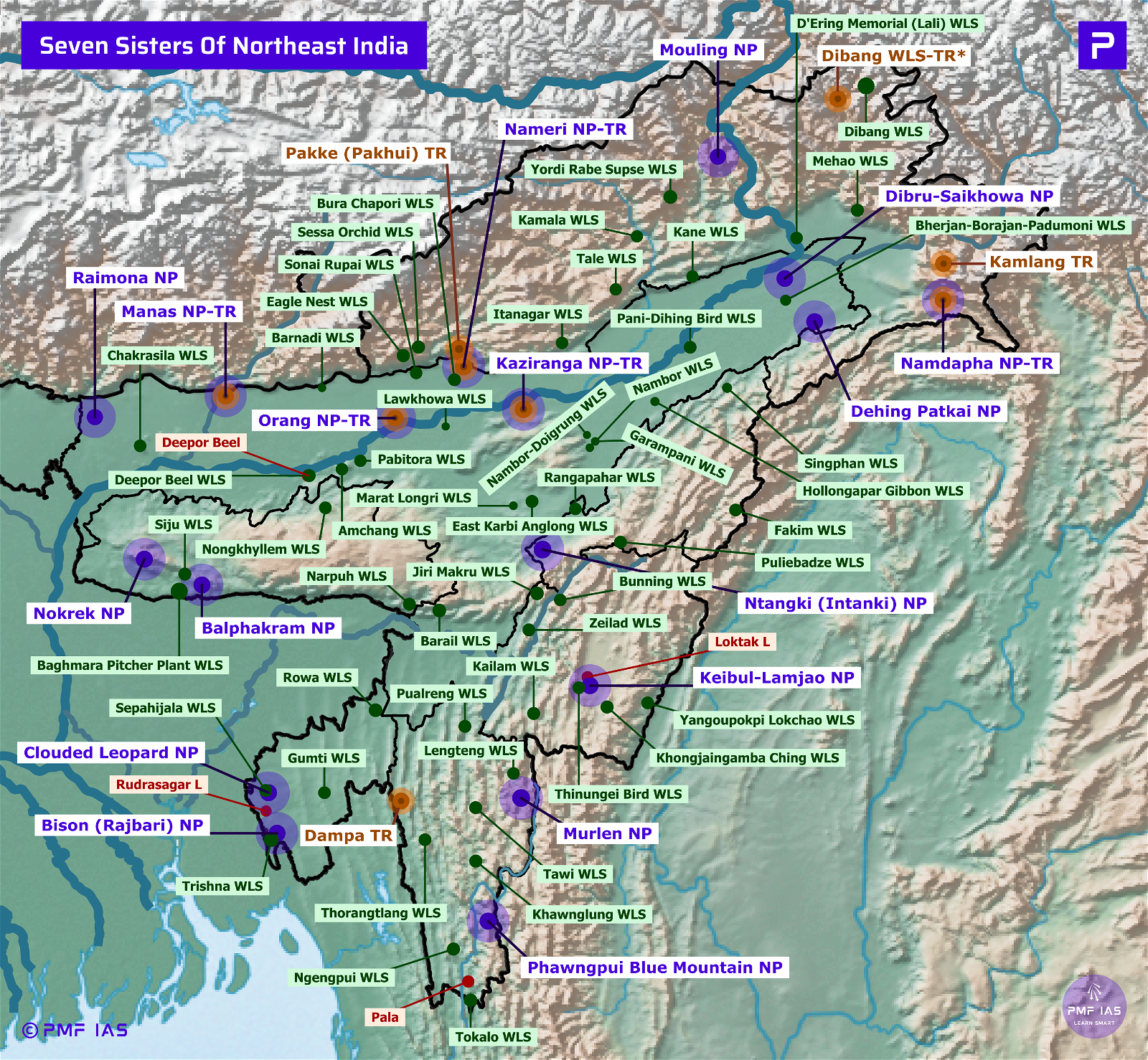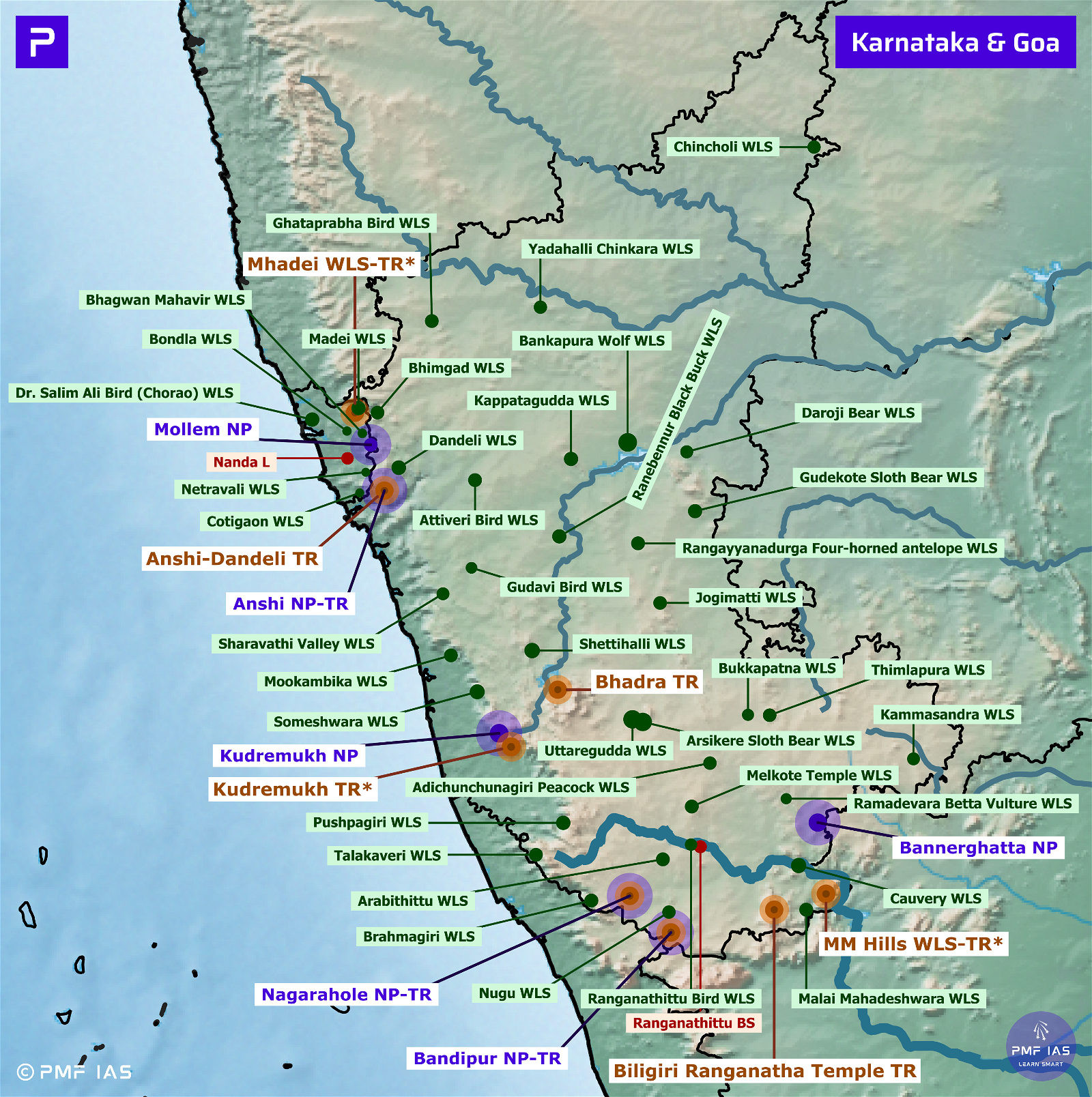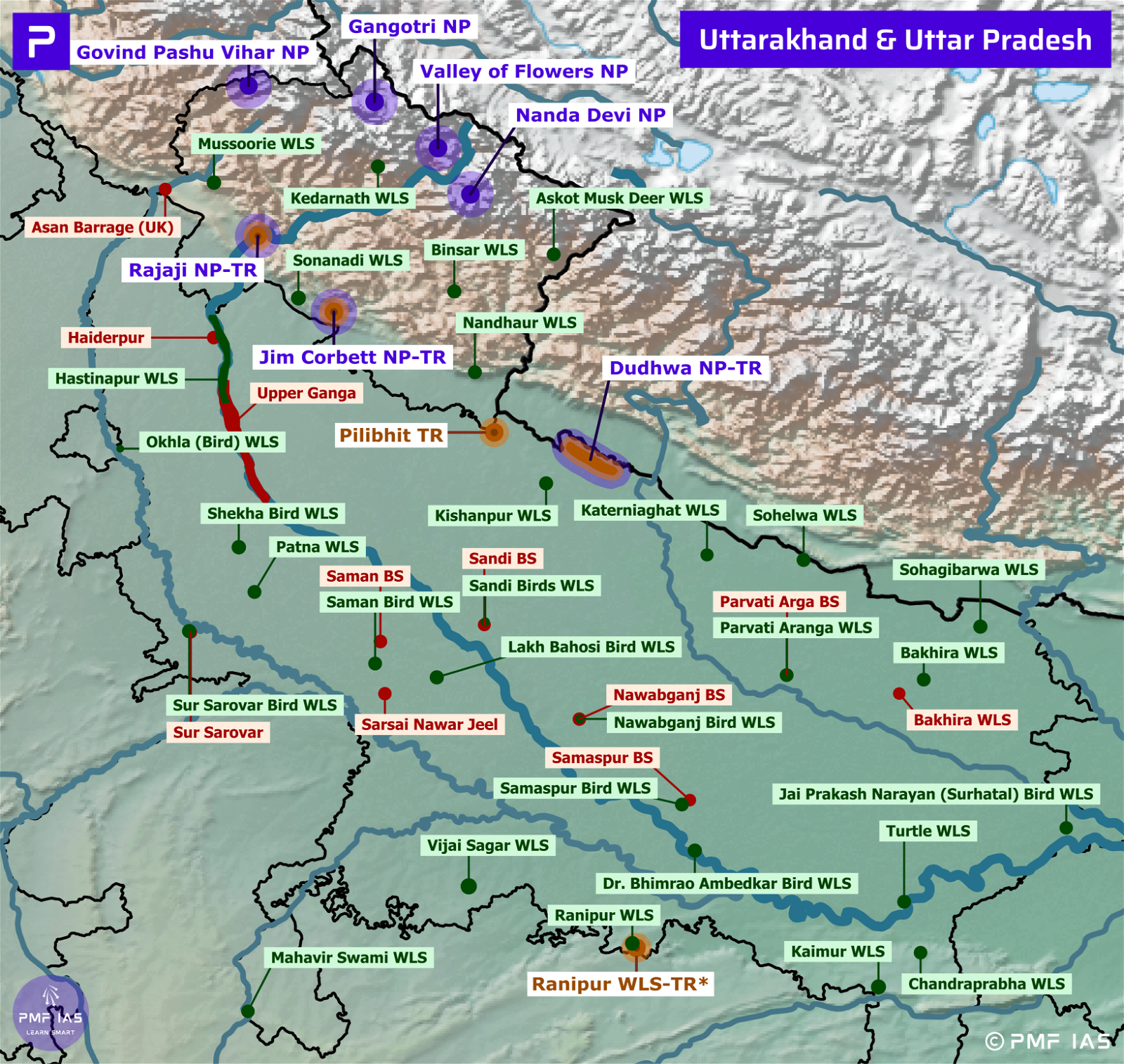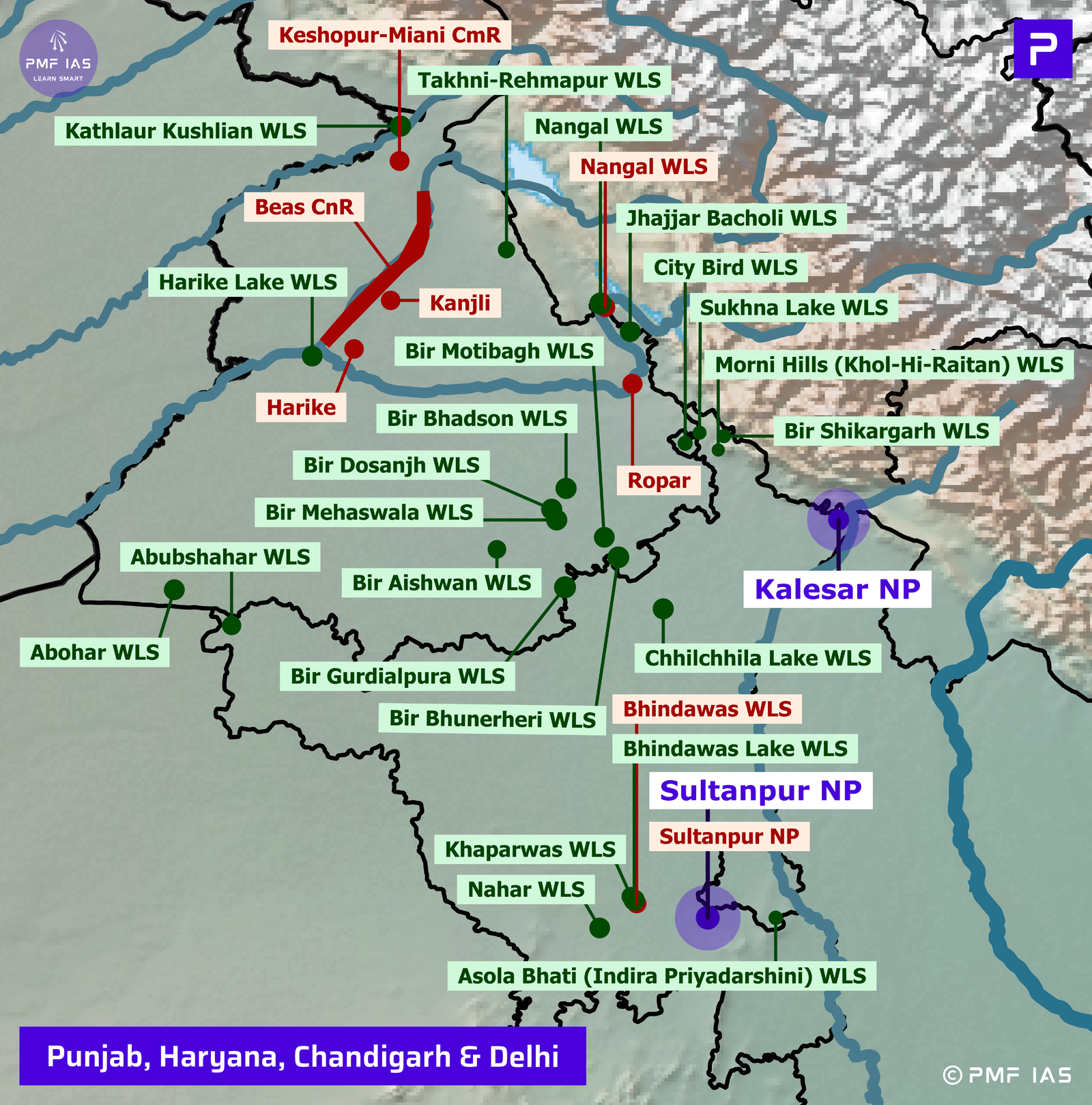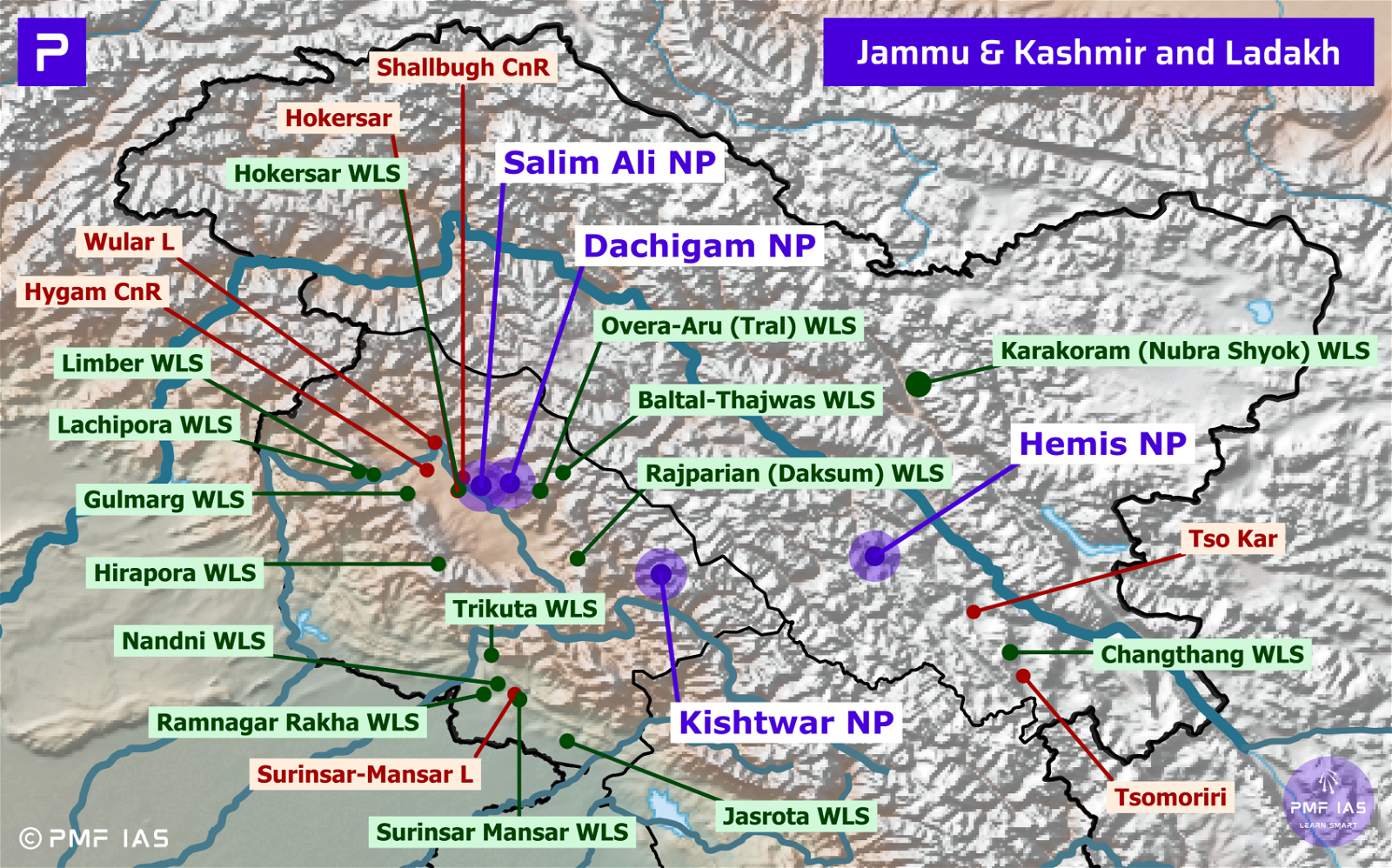
Kerala National Parks, Tiger Reserves, Wildlife Sanctuaries & Ramsar Sites
Subscribe to Never Miss an Important Update! Assured Discounts on New Products!
Must Join PMF IAS Telegram Channel & PMF IAS History Telegram Channel
Last updated on April 26, 2024 7:22 PM

Anamudi Shola National Park
- It is located along the Western Ghats. Anamudi (2695 m), the highest peak in peninsular India, is located in this Park and Eravikulam National Park.
- It is surrounded by Mathikettan Shola National Park, Eravikulam National Park, Pambadum Shola National Park, Chinnar Wildlife Sanctuary, and the Kurinjimala Wildlife Sanctuary. (All are part of Munnar Wildlife Division).
- Vegetation: tropical evergreen forests, wet montane forests, moist deciduous forests and shola forests.
- Major Fauna: Lion-tailed macaques, Nilgiri tahr (EN), Nilgiri marten (VU), gaur, muntjac, giant grizzled squirrel (NT), flying squirrels, Nilgiri langur (VU).
- Threats: Tourism-related construction, invasive species, severe deforestation for plantation crops like rubber, tea.
Sholas
- Sholas are tropical montane forests in the Western Ghats, separated by rolling grasslands in high altitudes.
- They house a dense patch of stunted trees with the presence of lichen, mosses, and climbers.
- The Shola patches occur only in the folds of the mountains that receive the least fog.
Eravikulam National Park
- It is located along the Western Ghats.
- Vegetation: High altitude grasslands and sholas.
- Major Fauna: Similar to Anamudi Shola National Park.
- Major Avifauna: Black-and-orange flycatcher
Mathikettan Shola NP
- It is located along the Western Ghats.
- Vegetation: Similar to Anamudi Shola National Park.
- Fauna: Similar to Anamudi Shola National Park.
Pambadum Shola National Park
- It is a part of Palani hills of Kerala and Tami Nadu.
- Similar to Anamudi Shola National Park.
Parambikulam Tiger Reserve
- It is located in the Sungam range of hills between Anaimalai Hills (TN) and Nelliampathy Hills (Kerala).
- Vegetation: Evergreen, moist deciduous, and sholas.
- Major Fauna: Lion-tailed macaques, Nilgiri tahr, Nilgiri langurs, Nilgiri marten, small Travancore flying squirrel.
Periyar National Park, Tiger Reserve, ER
- It forms the major watershed of two important rivers of Kerala, the Periyar and the Pamba. It is located in the Cardamom Hills of the Western Ghats.
- It surrounds the Periyar Lake which became a reservoir in 1895 after the Mullaperiyar Dam was erected. The dam is built at the confluence of Mullayar and Periyar rivers in Kerala but is operated and maintained by Tamil Nadu.
- Vegetation: tropical evergreen, semi-evergreen and moist deciduous forests, montane grasslands, montane savannas, wetlands, and lake and river ecosystems.
- Major Flora: Teak, rosewoods, sandalwoods, eucalyptus.
- Major Fauna: Travancore flying squirrel, Nilgiri tahr, lion-tailed macaque, Salim Ali’s fruit bat, Nilgiri marten.
- Major Avifauna: Malabar grey hornbill (endemic), Nilgiri wood pigeon, Nilgiri flycatcher.
Silent Valley National Park
- Silent Valley National Park is located in the Nilgiri Hills in the Malappuram district, Kerala, and Nilgiris district of Tamil Nadu. The park lies within the Nilgiri Biosphere Reserve.
- Bhavani River (a tributary of the Kaveri River) and Kunthipuzha River (a tributary of the Bharathappuzha River) originate in the vicinity of the park. The Kadalundi River also originates in this park.
- Vegetation: Rainforests, tropical moist evergreen forest and shola forests.
- Major Fauna: It is home to the largest population of lion-tailed macaques (EN). Other major fauna: Malabar giant squirrel, Nilgiri tahr, Travancore flying squirrel.
- Major Avifauna: Nilgiri wood-pigeon, Malabar grey hornbill, Nilgiri flycatcher.
- Threats: Livestock grazing and forest fires, illegal plantations of cannabis.
Wildlife Sanctuaries of Kerala
Aralam Wildlife Sanctuary
- It is located on the Western Ghats and it is contiguous with the Brahmagiri Wildlife Sanctuary of Karnataka.
- Nagarhole National Park and Tiger Reserve lies to the east of Aralam Wildlife Sanctuary.
Chimmony Wildlife Sanctuary
- It is located along the Western Ghats and is contiguous with Peechi-Vazhani Wildlife Sanctuary and Parambikulam Wildlife Sanctuary & Tiger Reserve.
- Nestled in the sanctuary is Chimmony Dam built across the Chimmony river.
Chinnar Wildlife Sanctuary
- It is located in the Idukki district and is contiguous with Eravikulam National Park, Indira Gandhi Wildlife Sanctuary (Anamalai Tiger Reserve & National Park) and Kodaikanal (Palani Hills).
- It forms an integral part of the protected forests straddling the Kerala-Tamil Nadu border in the Anaimalai Hills.
- It is under consideration for selection as UNESCO World Heritage Site.
- The Chinnar and Pambar rivers are the major perennial rivers in the Wildlife Sanctuary. The Chinnar River becomes the Amaravati River in Tamil Nadu.
- The rare Albino gaur (Manjampatti white bison) are found only in Indira Gandhi Wildlife Sanctuary and Chinnar Wildlife Sanctuary.
Idukki Wildlife Sanctuary
- It is cradled by the Cheruthoni River (tributary of the Periyar River) and Periyar River.
- It is located to the northwest of Periyar Tiger Reserve and to the southwest of Mathikettan National Park.
- Cardamom Hills lie between Mathikettan National Park and Idukki Wildlife Sanctuary.
- Periyar River originates near Periyar Tiger Reserve, flows from Mullaperiyar Dam to the Idukki Reservoir, flows entirely through Kerala and joins the sea in the Kerala.
Kottiyoor Wildlife Sanctuary
- It is situated in eastern hilly area of Kannur. It is adjacent to Aralam WLS and Nagarhole National Park.
Kurinjimala Wildlife Sanctuary
- It protects the core habitat of the endangered Neelakurinji plant in Idukki district. Neelakurinji is a shrub that is found in the shola forests of the Western Ghats.
- Nilgiri Hills (which literally means blue mountains) got their name from the purplish blue flowers of Neelakurinji that blossoms only once in 12 years.
- The Wildlife Sanctuary is contiguous to the Chinnar Wildlife Sanctuary, Eravikulam National Park, Anamudi National Park, Pampadum Shola National Park and the proposed Palani Hills NP.
Malabar Wildlife Sanctuary
- It is located along the Western Ghats. It is a part of Nilgiri Biosphere Reserve and Wayanad ER.
Mangalavanam Bird Wildlife Sanctuary
- It is situated at the Kochi city and supports many types of migratory birds and mangroves.
Neyyar Wildlife Sanctuary
- It spread over the southeast corner of the Western Ghats.
- It is the drainage basin of Neyyar River and Neyyar Dam.
- It is a part of the Agasthyamala Biosphere Reserve.
Peechi-Vazhani Wildlife Sanctuary
- It is the second oldest Wildlife Sanctuary of Kerala.
- It consists of Palappilli-Nelliyampathi forests, including the area of Chimmony Wildlife Sanctuary.
Shendurney Wildlife Sanctuary
- It is located in the Western Ghats and comes under the control of Agasthyamalai Biosphere Reserve.
Thattekad Bird Wildlife Sanctuary
- It is an evergreen low-land forest located between the branches of the Periyar River.
Wayanad Wildlife Sanctuary
- It an integral part of the Nilgiri Biosphere Reserve. It is bounded by Nagarhole National Park and Bandipur National Park (Karnataka) and Mudumalai National Park.
- It is a major elephant and tiger corridor.
Others
- Chulannur Peafowl Wildlife Sanctuary: Located in the Pal Gap/ Palghat Gap/Palakkad Gap in Palakkad district.
- Peppara Wildlife Sanctuary: Located to the north of Neyyar Wildlife Sanctuary and west of Agasthyamalai.
Wildlife Sanctuaries of Lakshadweep
Pitti (Bird Island) Wildlife Sanctuary
- It is an uninhabited coral islet in Lakshadweep.
- It is located about 24 km to the north of Kavaratti.
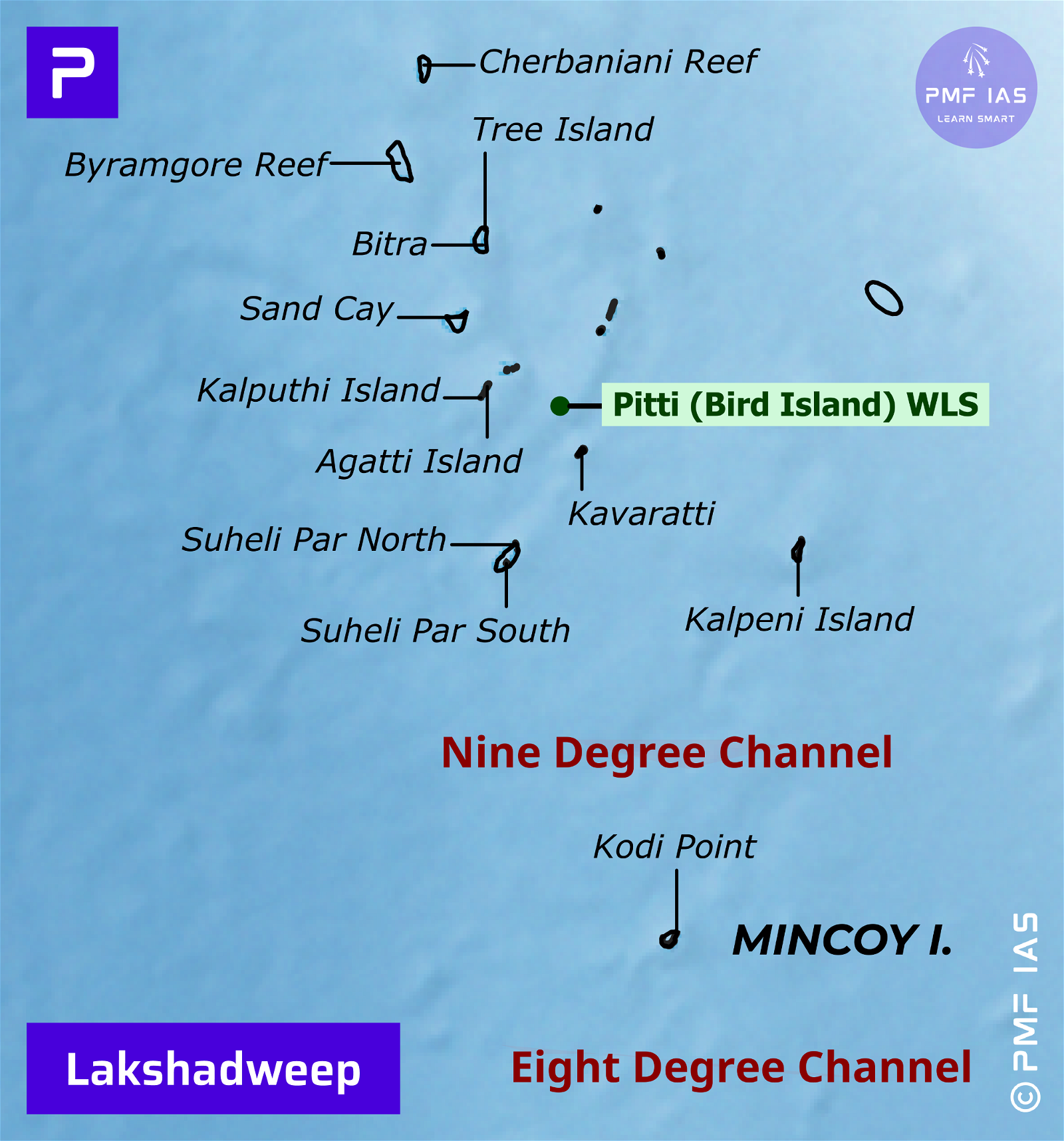
Ramsar Sites of Kerala (3)
Ashtamudi Wetland
- It is a natural backwater in the Kollam district. National Waterway 3 passes through it. It is the second-largest estuarine ecosystem in Kerala. It forms an estuary with the sea at Neendakara (a famous fishing harbour in Kerala). River Kallada and Pallichal drain into it.
Sasthamkotta Lake
- It is the largest freshwater lake in Kerala. River Kallada had a unique replenishing system through a bar of paddy fields. The replenishing mechanism is now being destroyed. The water contains no common salts & supports no water plants. A larva called cavaborus eliminates bacteria in water, thus contributing to its exceptional purity.
Vembanad-Kol Wetland
- It is the largest brackish lake of Kerala, spanning across Alappuzha, Kottayam, and Ernakulam districts. It is the second-largest Ramsar Site in India after Sundarbans. It is also the longest lake in India. It is below sea level and is famous for paddy fields that are below sea level.
Last updated on April 26, 2024 7:22 PM





